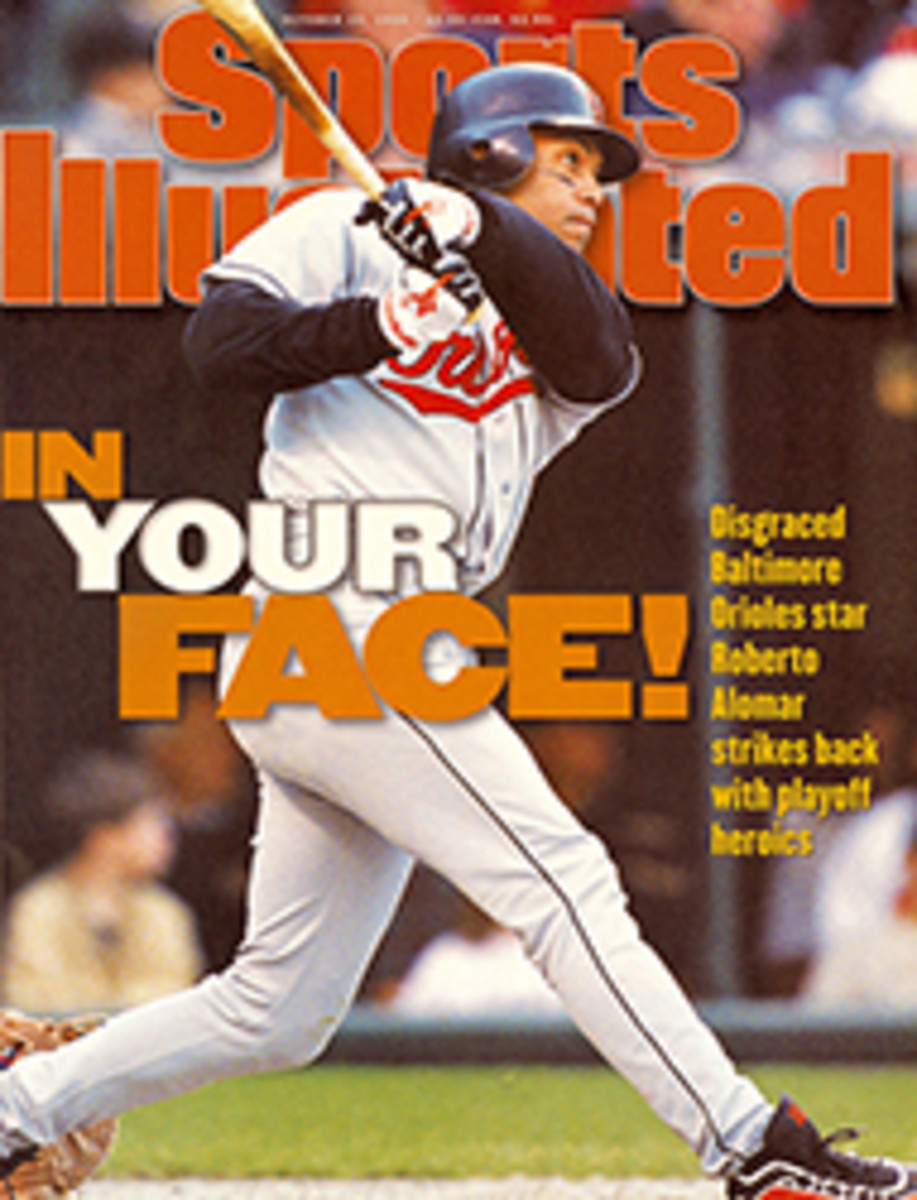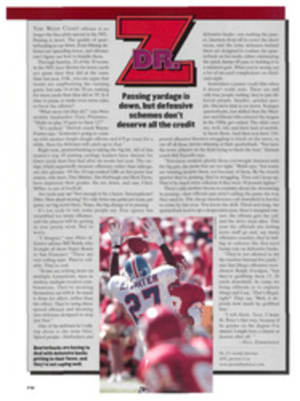
HIS MEMORY IS PERFECT DON LARSEN RECALLS DETAILS OF HIS FLAWLESS GAME IN 1956 AS IF IT WERE YESTERDAY
Don Larsen, 67, stands 6'4" and weighs close to the 225 pounds
he carried during his prime as a New York Yankees pitcher. His
sideburns are white, but his eyes shine a bright and youthful
blue. On a living-room table in the west Idaho home he shares
with Corrine, his wife of 38 years, 100 leather-bound copies of
The Perfect Yankee await Don's signature. The book, written with
Mark Shaw and released last month by Sagamore Publishing, is
being promoted as Larsen's autobiography. In fact, it does
little more than chronicle a single game.
It took Don Larsen precisely two hours and six seconds of an
autumn afternoon to create his life's legacy. He went to the
Yankee Stadium mound at 1:03 p.m. on Oct. 8, 1956, to face the
Brooklyn Dodgers in the fifth game of the World Series, and when
the Yankees' 2-0 victory was complete, the phrase Don Larsen's
perfect game entered the American lexicon. Larsen's effort, 27
up and 27 down, is the most famous single-game pitching
performance in baseball history. "I think about it every day,"
Larsen says.
Four decades ago Larsen was a righthander four seasons into what
would be an erratic 14-year career. Despite the fact that he had
gone 3-21 with the Baltimore Orioles in 1954, the Yankees had
requested his inclusion in a multiplayer trade between the two
teams after that season. Larsen rewarded New York by going 20-7
over the next two years. He also earned a reputation as an
enthusiastic partygoer who, one late night in the spring of '56,
drove a car into a telephone pole and escaped unmarked, except
for a chipped tooth. Larsen was an affable sort who read comic
books by the stack and was nicknamed Gooney Bird by his
teammates. In Mickey Mantle's memoir My Favorite Summer--1956,
Mantle, who played centerfield in the perfect game and whose
opinion was expert, called Larsen "the greatest drinker I've
known."
But Larsen wasn't drinking the night before the fifth game of
the '56 Series. Expecting to be called out of the bullpen by
Yankees manager Casey Stengel, he simply went out for
dinner--"Well, and maybe just a couple of beers," he
concedes--then returned to his Bronx hotel room before midnight
and went to sleep. The next morning Larsen raised the shades to
see a sunny sky. Without eating breakfast, he left the hotel and
walked three blocks through the crisp air to the Stadium. When
he got to his locker, he found a baseball in his left shoe. That
was Stengel's way of telling him he was the starting pitcher. "I
just stood there, very surprised," says Larsen, who had lasted
less than two innings as a starter in the Yankees' 13-8 loss in
Game 2 of the Series. "I didn't want to mess it up."
Today, after decades of telling and retelling the story of his
seminal game, Larsen can scrutinize every at bat and assign to
each a lasting significance. Yet as he recalls the game, it
becomes clear that as he pitched it, events unfolded largely in
a blur. The Series was knotted at two games apiece, and the
Dodgers lineup, with Jackie Robinson, Duke Snider, Roy
Campanella and Carl Furillo, seemed relentless. The game was
close--1-0 on a Mantle home run in the fourth inning, 2-0 after
six. Larsen, pitching against the crafty Sal Maglie,
concentrated on keeping the Yankees on top.
Larsen had marvelous control. "The best ever," he says. "Lord
knows why I had it that day." He worked fast, throwing biting
sliders, moving fastballs and occasional curves, all with his
signature no-windup style. "All I knew," Larsen says, "was that
I felt good."
Larsen got ahead of batters (a full count to Pee Wee Reese in
the first was the only three-ball count of the game) and kept
them off balance. But Larsen was also fortunate. In the second
Robinson lashed a ground ball off third baseman Andy Carey that
rebounded to shortstop Gil McDougald, who threw Robinson out by
less than a step. Two batters--Snider in the fourth and Sandy
Amoros in the fifth--hit balls with home run distance that
landed foul by less than 18 inches. And in the fifth inning
Mantle brought the crowd to its feet by outrunning a 400-foot
drive by Gil Hodges and snaring it with his back to home plate.
Still, it was not until after Larsen had set down the Dodgers in
the seventh inning that he realized what might happen. Sitting
in the dugout, a lit cigarette in his hand, he stared out at the
scoreboard and saw the string of zeros. "Hey, Mick," said Larsen
to Mantle, who was beside him. "Look at that. Two more innings.
Wouldn't it be something."
Mantle stood and walked away without saying a word. At that
point superstition took over. No one dared mention the no-hitter
or even talk to Larsen. The dugout, usually full of banter, fell
suddenly silent. "It was lonely in there those last two
innings," Larsen recalls. "The only time I felt comfortable was
when I was on the mound."
In the top of the eighth Larsen handled his only fielding chance
of the game and threw out Robinson at first. And with one out in
the bottom half, the fans up and roaring, Larsen came to the
plate. He tried to block out the noise, tried to ignore the
confetti drifting down from the stands. But, though he was a
dangerous hitter, Larsen went out meekly on strikes. Moments
later he came out to pitch the ninth inning, and Yankee Stadium
was, in Yogi Berra's inimitable words, "As loud as I've ever
seen it."
Furillo made the first out, on a fly ball; then Campanella made
the second, on a grounder. And then, with pinch hitter Dale
Mitchell coming to the plate, Larsen stepped off, lifted the
rosin bag and came back to the rubber. He threw a ball, two
strikes, and then Mitchell fouled one off. On the next pitch,
Larsen's 97th of the game, a fastball that shaved the outside
corner, umpire Babe Pinelli called Mitchell out on strikes.
Berra ran to the mound and leaped into Larsen's arms. Fans
stormed onto the field.
Larsen says he didn't know what a perfect game was until someone
told him afterward. He thought he had simply thrown a no-hitter.
And even in the frenzied clubhouse, where Larsen was besieged by
the media for hours, visited by Maglie and even asked to sign an
autograph for Dodgers owner Walter O'Malley, it didn't really
sink in. It was only later, when he called his mother in
California and heard the pride in her voice, that he began to
understand his achievement.
Though he made numerous television appearances after the game
and received countless gifts and endorsements, and though he
pitched well for two more years for the Yankees, Larsen never
again had a brush with greatness. By the summer of '59 there was
talk of moving him, because of his strong bat, to the outfield
(which never happened), and after that season he was traded to
Kansas City, where he went 1-10. Larsen stayed in baseball until
1968, moving in and out of the minor leagues and bouncing among
11 teams. He finished with a lifetime record of 81-91. "People
said I didn't do enough in my career," Larsen says, "and maybe
they're right. But I had one great day."
In 1993, after 24 years as a paper salesman in California,
Larsen moved to Hayden Lake, Idaho. He and Corrine built a home
on the shore of a sheltered cove. Standing together on their
deck on a late September day, they look down past the northern
pines to a boat rolling gently against a small dock. "You get
trout in there, and bass," says Larsen. The phone rings
regularly with interview and appearance requests. In a few days
the Larsens will leave their idyllic retreat to promote The
Perfect Yankee in New York City. "Mind?" says Corrine. "We like
it."
Don nods and brushes some pine needles off the railing of the
deck. "That was an amazing thing that happened," he says,
pensively. "I'm just glad that it happened to me."
COLOR PHOTO: RICH FRISHMAN Larsen, at home in Hayden Lake, didn't understand the import of the game until he called his mom. [Don Larsen]
COLOR PHOTO: AP After the final out, Larsen got a bear hug from Berra. [Don Larsen and Yogi Berra hugging]

